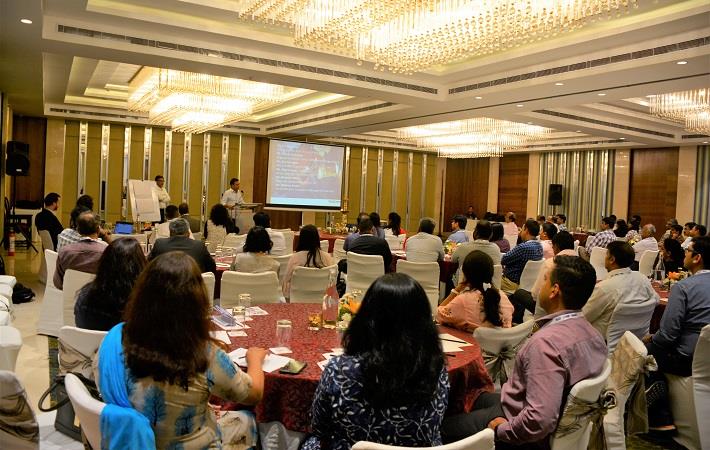New social audit initiative launched in India

By Rehmat Merchant
There has been a proliferation of audits over the last two decades as a result of the compliance-focused approach that has nevertheless played a role in improving social and labour conditions in the apparel sector. A new initiative—Social and Labour Convergence Program (SLCP)— now seeks to create "sustainable remediation" that will promote collaboration and free up precious resources which can be redirected to tangible programmes for lasting improvements on working conditions.
The SLCP, in association with Shahi Exports, kicked off its project in India earlier this week in Bengaluru with a day-long seminar for stakeholders. Similar events in other cities will follow.
What is SLCP?
For any facility that manufactures apparel for brands, social and labour auditing can turn out to be a nightmare. During a discussion game for participants, one group described the angst of auditing: you are looking to fulfil all the codes of ethics of different clients and in the process forget your own.
This is where the SLCP steps in. It is an initiative which has international manufacturers, brands, retailers, industry groups and civil society organisations as signatories. The idea is to do away with audit fatigue by replacing current proprietary tools with a standard-neutral converged assessment framework.
Sharon Hesp, senior manager operations at SLCP, said that the initiative is not a code of conduct or compliance programme. Its framework provides a dataset with no value judgement or granting of scores. “The SLCP model collects data and refrains from benchmarking. It is, however, in sync with audit systems and codes of conduct currently used in the industry,” said Hesp. This makes it possible for the same data to be used by various stakeholders. Each user can then interpret the dataset according to their interests and criteria. “We have collated 97 per cent of the code of conduct of most brands. The three per cent that is not included is not important,” she said.
Srinivasan Venkat Rao, chief compliance officer at Shahi Exports, the host company for the launch, said: “The SLCP is a new platform for convergence that removes audit fatigue and the multiplicity of effort. It creates one reference point for social and labour comparison and aids global transparency.”
Madison Wilcox, associate sustainability officer at the International Trade Centre (ITC), was a speaker at the seminar. ITC, a joint agency of the United Nations and the World Trade Organisation, has collaborated with the SLPC to provide trade-related technical assistance. “We support small and medium enterprises (SMEs) in developing economies to connect with international markets. We began working with the SLPC to bring together different actors in the system,” said Wilcox. ITC will provide the gateway for uploading the verified assessments, which would be shared with accredited hosts, on secure servers.
How does SLCP work?
The first step is data collection—which is a self-assessment report—carried out by the manufacturing unit. This would be followed by data verification by an attested third party institution. The verifiers would visit the facility to verify the data claims. There would be no value judgement at this stage—only a cross-checking of the entries recorded by the facility. If there is a discrepancy, it would be resolved before the data is passed on to the hosting and sharing platform. The training for data collection and verification is provided on the SLCP gateway and is mandatory.
The SLCP eliminates the need for the facility to carry out multiple audits for different clients. So instead of doing an audit for each brand-client, the facility management can do a single audit, which in turn is verified by a single agency. Of course, the SLCP model assumes that all the brands at an existing manufacturing unit are signatories to the SLCP. The uploaded data can be accessed from the host platform by the brands and rated according to their own standards.
“The data collection tool covers the life cycle of an employee,” said Hesp. That would cover wages, health and safety standards, working hours, hiring processes, termination, forced labour and child labour. There are roughly 3,000 data points to be filled out depending on the facility size and operations. On an average, an audit could take between two and six days with at least two verifiers.
The outcome
The SLCP model has the confidence that comes from three years spent in development and testing: three prototypes, two pilots, a public consultation and a “light operation” in 2018 in China and Sri Lanka. Hesp said the markets were chosen to test various conditions: Sri Lanka was small, locations were close by, and it was English-speaking, whereas China was big, with locations spread apart and was non-English speaking. But the system worked. Said Hesp: “It’s a global tool. It’s made for different conditions in different countries. And the focus differs in all countries.”
Abhishek Bansal, head of sustainability at Arvind Group, spoke about their involvement with the SLCP since 2016. He told the participants that the 3,000-odd data points were relevant to very few organisations. “It is designed in a modular way and readjusts according to scale and operating conditions of the factory. If you don’t have on-site dorms or young workers, a lot of questions go away.” According to Bansal, an average of 800 data points would apply to most facilities. “The tool will not only eliminate audit fatigue, but also give ownership of the data to the factory,” said Bansal. It would also help managements understand what is accepted of a factory, he concluded.
Sadia Sharmin, manager social sustainability for South Asia (Bangladesh, India, Sri Lanka) at Puma, said that they had participated in a pilot project and the “light operation” in China. “Social audits have been a burden on suppliers; so, we decided to participate with brand partners and suppliers. We are definitely a part of the movement,” she said. According to her, the tool enables brands to feed in their checklist after the data has been verified and uploaded: “Different brands will use the data differently. They can generate ratings according to their code of conduct and work on their remedial plans.”
Sharmila Nithyanand, senior social responsibility specialist at Gap Inc, said that they had already implemented the SLCP in Bengaluru, and are targeting around 20 factories and mills in India this year. Gap has been a part of the project-testing right from compliance to assessment to participation. “Compliance and audit fatigue have to be done away with. We need a uniform assessment tool across the industry,” said Nithyanand.
PVH—which owns brands like Calvin Klein, Tommy Hilfiger, and Van Heusen—was involved in the SLCP pilot in India and the “light operation” in Sri Lanka. Hemachandra Prabhu, a CSR professional at the organisation, who played an active part in these operations, said: “There are no ratings after verification. There is no violation—only incorrect information. We have to calibrate the gaps between self-assessment and verification.”
What next?
The SLCP model hopes to eventually enhance working conditions of a facility by channelling resources that were earlier used for compliance audits towards the training and social needs of the labour force. According to research conducted by the SLCP in 2018, the adoption of initiative could free resources worth over $1.5 million otherwise spent on duplicative audits in 2019 itself and expected to rise to $200 million by 2023. The 190-plus SLCP signatories are now gearing up for adopting the model across apparel and footwear supply chains. In the first roll-out phase in mid- 2019, the SLCP is launching operations in India, China, Sri Lanka and Taiwan. (WE)
Fibre2Fashion News Desk – India
































-Ltd..jpg?tr=w-120,h-60,c-at_max,cm-pad_resize,bg-ffffff)





.jpg?tr=w-120,h-60,c-at_max,cm-pad_resize,bg-ffffff)
.jpg?tr=w-120,h-60,c-at_max,cm-pad_resize,bg-ffffff)






